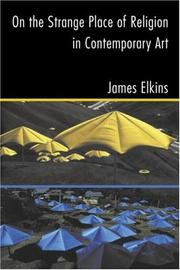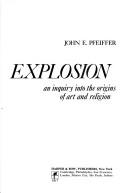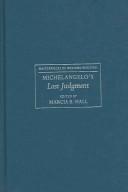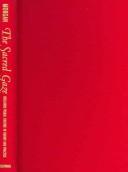| Listing 1 - 10 of 81 | << page >> |
Sort by
|
Book
ISBN: 9004447598 9789004447592 Year: 2020 Publisher: Leiden Boston
Abstract | Keywords | Export | Availability | Bookmark
 Loading...
Loading...Choose an application
- Reference Manager
- EndNote
- RefWorks (Direct export to RefWorks)
This slim volume offers a thematic exploration of religion and the digital arts. Over the course of six brief sections, this extended essay examines identity and community, authority and authenticity, word and image, ritual and practice, body and space, and myth and faith. Each of these paired sets is explored in concert with technologically inflected correlates. For instance, identity and community are paired with avatars and networks. These twin concepts provide the thematic anchor of each section. Each section looks at four works of digital art with each work employing digital technology in a unique way. The works include virtual and augmented reality pieces, 3D printed sculptures, digital photography, and digitally enabled performance pieces and installations and span the late 1990s to the present. This essay is an introduction to religion and the digital arts and, while no single conclusion can be drawn from such an expansive and diverse field, the reassertion of the religious and theological importance of the body and emotions in the face of digital technology emerges as a recurrent theme.
Book
ISBN: 1621897524 9781621897521 Year: 2013 Publisher: La Vergne Wipf and Stock Publishers
Abstract | Keywords | Export | Availability | Bookmark
 Loading...
Loading...Choose an application
- Reference Manager
- EndNote
- RefWorks (Direct export to RefWorks)

ISBN: 1135879710 1280063181 0203324862 9780203324868 9780415969888 0415969883 9780415969895 0415969891 9786610063185 6610063184 9781135879716 9781135879662 1135879664 9781135879709 1135879702 9781280063183 0415969891 0415969883 Year: 2004 Publisher: New York Routledge
Abstract | Keywords | Export | Availability | Bookmark
 Loading...
Loading...Choose an application
- Reference Manager
- EndNote
- RefWorks (Direct export to RefWorks)
For millennia, art has been religious - even in times and places when there was no word for 'art'. Then, in the Renaissance, it became possible for art to glorify the artist, making viewers think more of his skills than of the subjects he portrayed. The modern artist faces a more complex dilemma - one that no art historian has talked about until now.Can contemporary art say anything about spirituality? Is contemporary art is spiritual? What might it mean to say that the art you make expresses your spiritual belief?The Impossibility of Transcendence is about the curious disconnect between spir
Art and religion. --- Modernism (Art) --- Art --- Study and teaching (Higher) --- Art and religion
Book
ISBN: 9783110479201 3110479206 9783110477283 311047736X Year: 2022 Publisher: Berlin Boston
Abstract | Keywords | Export | Availability | Bookmark
 Loading...
Loading...Choose an application
- Reference Manager
- EndNote
- RefWorks (Direct export to RefWorks)
A pioneering interdisciplinary study of the art, production and social functions of Late Antique ritual artefacts. Utilising case studies from the Graeco-Egyptian magical papyri and the Heidelberg archive it establishes new approaches, provides a holistic understanding of the multi-sensory aspects of ritual practice, and explores the transmission of knowledge traditions across faiths.

ISBN: 0060133457 Year: 1982 Publisher: New York (N.Y.) : Harper and Row,
Abstract | Keywords | Export | Availability | Bookmark
 Loading...
Loading...Choose an application
- Reference Manager
- EndNote
- RefWorks (Direct export to RefWorks)
Art and religion. --- Art, Prehistoric. --- Art and religion --- Art, Prehistoric --- Prehistoric art --- Art, Primitive --- Art --- Arts in the church --- Religion and art --- Religion --- Religious aspects

ISBN: 0521780020 0521783682 Year: 2005 Volume: *5 Publisher: Cambridge Cambridge University Press
Abstract | Keywords | Export | Availability | Bookmark
 Loading...
Loading...Choose an application
- Reference Manager
- EndNote
- RefWorks (Direct export to RefWorks)
Michelangelo's Last Judgment was the most criticized and discussed painting of the sixteenth century. The subject of the Last Judgment has been a barometer of cultural mood throughout history. It can be interpreted, as Michelangelo did, as the moment when mortals attain immortal bliss or, in more unsettled times, as the terrifying moment when we face the justice of the Lord and are found wanting. The painting must hold in tension admonition and celebration. Michelangelo created his fresco in the final flowering of Renaissance humanism. Four years after its unveiling, the Council of Trent began meeting and the Counter-Reformation was under way. Caught on the cusp of a major shift of values, Michelangelo and his fresco were praised by lovers of art and condemned by conservative churchmen who sought a tool with which to exhort the wavering faithful, tempted to defect to Protestantism. This book explores the context, both historical and biographical, in which the fresco was created and the debates about the style and function of religious art that it generated.
Michelangelo --- Art and religion --- History --- Michelangelo Buonarroti, --- Michelangelo Buonarroti --- Italy --- 16th century --- Buonarroti, Michelangelo

ISBN: 1282763148 9786612763144 0520938305 1417585102 9780520938304 1597349461 9781597349468 9780520925618 0520925610 0520242874 9780520242876 0520243064 9780520243064 9781282763142 Year: 2005 Publisher: Berkeley University of California Press
Abstract | Keywords | Export | Availability | Bookmark
 Loading...
Loading...Choose an application
- Reference Manager
- EndNote
- RefWorks (Direct export to RefWorks)
""Sacred gaze"" denotes any way of seeing that invests its object-an image, a person, a time, a place-with spiritual significance. Drawing from many different fields, David Morgan investigates key aspects of vision and imagery in a variety of religious traditions. His lively, innovative book explores how viewers absorb and process religious imagery and how their experience contributes to the social, intellectual, and perceptual construction of reality. Ranging widely from thirteenth-century Japan and eighteenth-century Tibet to contemporary America, Thailand, and Africa, The Sacred Gaze
Art and religion. --- Art --- Arts in the church --- Religion and art --- Religion --- Religious aspects
Book
ISBN: 1621895890 9781621895893 162032475X 9781620324752 Year: 2013 Publisher: Eugene, Oregon
Abstract | Keywords | Export | Availability | Bookmark
 Loading...
Loading...Choose an application
- Reference Manager
- EndNote
- RefWorks (Direct export to RefWorks)
Art and religion. --- Art --- Arts in the church --- Religion and art --- Religion --- Religious aspects
Book
ISBN: 0231541996 9780231541992 9780231178181 0231178182 Year: 2016 Publisher: New York, NY
Abstract | Keywords | Export | Availability | Bookmark
 Loading...
Loading...Choose an application
- Reference Manager
- EndNote
- RefWorks (Direct export to RefWorks)
How are we to think of works of art? Rather than treat art as an expression of individual genius, market forces, or aesthetic principles, Michael Jackson focuses on how art effects transformations in our lives. Art opens up transitional, ritual, or utopian spaces that enable us to reconcile inward imperatives and outward constraints, thereby making our lives more manageable and meaningful. Art allows us to strike a balance between being actors and being acted upon. Drawing on his ethnographic fieldwork in Aboriginal Australia and West Africa, as well as insights from psychoanalysis, religious studies, literature, and the philosophy of art, Jackson deploys an extraordinary range of references-from Bruegel to Beuys, Paleolithic art to performance art, Michelangelo to Munch-to explore the symbolic labor whereby human beings make themselves, both individually and socially, out of the environmental, biographical, and physical materials that affect them: a process that connects art with gestation, storytelling, and dreaming and illuminates the elementary forms of religious life.
Art and religion. --- Art --- Arts in the church --- Religion and art --- Religion --- Religious aspects
Book
ISBN: 1108648789 1108564461 1108631274 1108473075 9781108564465 9781108473071 9781108460941 Year: 2020 Publisher: Cambridge Cambridge University Press
Abstract | Keywords | Export | Availability | Bookmark
 Loading...
Loading...Choose an application
- Reference Manager
- EndNote
- RefWorks (Direct export to RefWorks)
This book reveals the rewards of exploring the relationship between art and religion in the first millennium, and the particular problems of comparing the visual cultures of different emergent and established religions of the period in Eurasia - Buddhism, Hinduism, Zoroastrianism, Islam, Judaism, Christianity and the pagan religions of the Roman world. Most of these became established and remained in play as what are called 'the world religions'. The chapters in this volume show how the long traditions of studying these topics are caught up in complex local, ancestral, colonial and post-colonial discourses and biases, which have made comparison difficult. The study of Late Antiquity turns out also to be an examination of the intellectual histories of modernity.
Art and religion --- Art --- Arts in the church --- Religion and art --- Religion --- History --- Religious aspects
| Listing 1 - 10 of 81 | << page >> |
Sort by
|

 Search
Search Feedback
Feedback About UniCat
About UniCat  Help
Help News
News